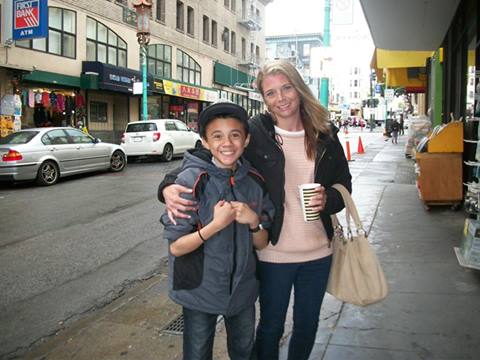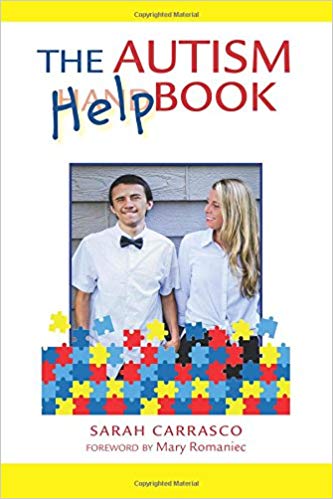August 16, 2018
When a child receives a diagnosis of autism, parents are often left feeling bewildered and overwhelmed by the road ahead. When my son David was diagnosed with autism twelve years ago, I was handed a piece of paper with a recommendation for thirty-five hours a week of therapy, and that was it. As I carried my newly diagnosed child to the car, him kicking and screaming, I thought to myself, This is it? One piece of paper is supposed to help me map out his future?
I spent the years following his diagnosis of “worst-case scenario for autism” calling every organization I could think of. I spent every lunch break at work calling therapy centers, our insurance company, and respite providers. Finding resources for him consumed every free moment I had for several years.

Sarah Carrasco and her son, David
In time, I got a handle on services and resources, and eventually, parents from all over the country started reaching out to me for help with their children. Four hundred families later, I have identified the greatest needs in our community and have consolidated this information into one easy-to-read book.
The Autism Helpbook is the book I looked for when David was diagnosed with autism. I start the book with a chapter on self-care and provide resources for respite care. For example, I added a link to Community Centered Boards (CCBs) by state. CCBs are disability resource centers designed to help parents access local resources. Self-care for parents of children with autism is not selfish, it’s a necessity, and I provide avenues to pursue respite care, so parents can get a much-needed break.
In addition to respite care, your child’s diagnosis paves the way for services and therapies. Your child’s diagnosis comes with a diagnostic code; that code opens doors for services. I teach parents how to make the most of the diagnostic code. If your child was diagnosed with Asperger’s, for example, the diagnostic code of F84.5 makes access to services difficult, but guess what? If you apply for services or therapy through your insurance company and are denied, upwards of 90% of parents win on appeals. I will teach you how to appeal a denial with a letter of medical necessity.
D on’t know which therapies to pursue? No problem. The Autism Helpbook breaks down all of the major (and alternative) therapies for you so YOU can decide which therapies will work best for your child and for your family.
on’t know which therapies to pursue? No problem. The Autism Helpbook breaks down all of the major (and alternative) therapies for you so YOU can decide which therapies will work best for your child and for your family.
What about autistic behaviors and underlying medical conditions? I address those too with a chapter on biomedical interventions, complete with food lists and a breakdown of just about every biomedical intervention there is.
Does your child wander? This book lists GPS tracking devices and tips for keeping your little angel safe at home, at school and on vacation.
How about the transition into adolescence and adulthood? Nerve-racking, right? No worries. The Autism Helpbook provides links to chore charts for teenagers with autism, adding ADLs to the IEP, and links to resources for teenagers with autism. This book also explains the transition into adulthood, guardianship and Special Needs Trusts.
Is special education and the IEP process intimidating? Yes, it is. This book provides a list of acronyms used in IEP meetings, legal requirements of the Individuals with Disabilities Education Act (IDEA), and parents’ and students’ rights under the IDEA. I explain the need for adding a Transportation Plan, Behavior Plan, and Health Plan to the IEP in certain situations. In addition to learning about the law pertaining to special education, parents will learn how to teach their child with autism to read and do basic math.
Is life with autism hard for parents? It can be. Is it harder on the child who lives autism every day? Absolutely. The final chapter is a compilation of stories and writings by people with autism. In order to fully understand how and what our children feel, we need to hear from them, in their words, not mine. I conclude the book with “Life with Autism” because our children have a voice. Whether they communicate verbally, with picture cards, through the use of a communication device or sign-language, their voices and their experiences matter. In many cases, they will not come into our world, we must come into their world; the final chapter gives parents a glimpse into the lives of people with autism to help increase understanding of this complex disorder.
The Autism Helpbook is the book I needed when David was diagnosed. It is my hope that this book alleviates stress and relieves pressure on parents so they can help their child live their best life. There is hope for a life restored, and this book paves the way for the restoration of a prosperous and fruitful life for children with autism and their families.
~ Sarah Carrasco
For more by Sarah Carrasco, click here.

















Aluminum and mercury detox? Goodness, where is this available and how much does it cost?
Not on topic, sorry, but I have run across a similar sort of headline/article often, and often thought/wondered…”gee, wonder if the wide vaccine use might have some impact?”————————-
“Widespread declines in life expectancy across high income countries coincide with rising young adult and midlife mortality in the United States
Urgent need to examine systemic causes of declining health in the US”
Try detoxing for heavy metals,mercury and aluminium. Then get speeded up learning. The so called autistic children in the WiseOnes program are changed in a few weeks, joining im everything once they trust the teacher. It makes us so happy to see this. Pat